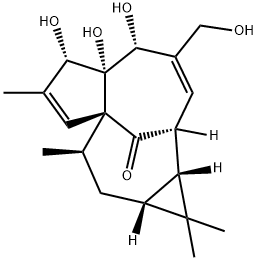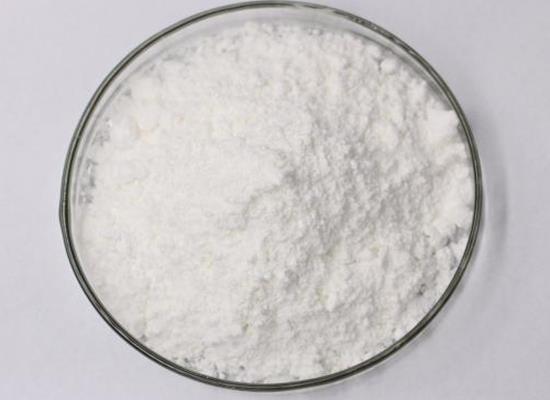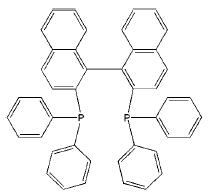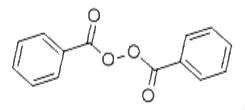Total Synthesis of Ingenol
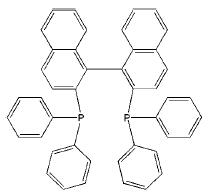
Fig 1. ingenol (1)
Isolated in 1968, ingenol (1), a highly oxygenated tetracyclic diterpene classified as a member of the phorboid family, is the parent compound of several dozen naturally occurring ingenanes that possess the same carbon skeleton but varied peripheral functionalities. In addition to their intriguing “inside-outside” bridged BC ring system, the ingenanes display interesting biological profiles that range from tumorpromoting to anti-leukemic and anti-HIV activities. Since the early 1980s, this combination of important biological function and complex architecture has inspired the efforts of numerous synthetic chemists.4 Previously, we reported an approach toward 1 wherein known â-ketoester 2 was advanced to diene 3, which served as a ring-closing metathesis substrate in a first generation Grubbs reaction that delivers the ingenane tetracycle 4 (Scheme 1).

Scheme 1
Although this work established the feasibility of ring closure via metathesis chemistry, further experiments indicated that competing ring-opening reactions were likely responsible for the observed poor conversion. This, coupled with the underfunctionalized nature of 4, led us to explore a modified substrate (5), which, upon ring closure, would furnish a more stable trisubstituted olefinic product 6 possessing the requisite C-20 hydroxymethyl group. In the event, we were delighted to find that substrate 5 undergoes ring-closing metathesis with improved yield and catalyst loading with respect to diene 3 (Scheme 2).

Scheme 2
Since the mid-1980s several approaches for constructing trans- as well as cis-fused ingenane skeletons have been developed, but only a few have succeeded for the former. Winkler reported the first synthesis of an ingenane tricyclic ring system having the correct transbridgehead stereochemical relationship using an intramolecular version of the modified de Mayo reaction (eq 3). Namely, irradiation of dioxenone 2 afforded [2 + 2] photoadduct 3, whose cyclobutane ring underwent fragmentation to the keto ester. Subsequent elimination of HCl, reduction, and protection afforded 4.
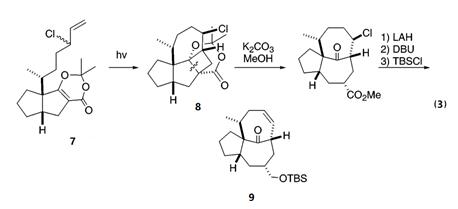
Rigby13 converted the out-out bicyclo undecadieneol 10 , accessible by Pd-mediated ring opening of the epoxide, into the more strained in-out stereoisomer 11 using an alkoxide-mediated sigmatropic H shift to establish the stereochemistry of the C-8ß8 bridgehead hydrogen (eq 4).

At present, in addition to our methodology including cationic cyclization, two groups15 have succeeded in constructing the ring system using RCM methodology. However, due to the longer distance (3.8 Å for 12a, 3.6 Å for 12b) between the two terminal olefins, a first generation of Grubbs catalyst has proven less effective to induce cyclization, giving the cyclized products in only moderate yields. Use of a large amount of catalyst as well as appropriate choice of substituent seems to be required to effect the desired RCM.
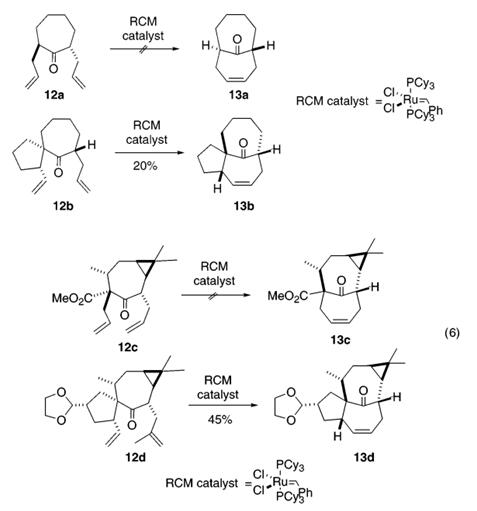
Thus, several methodologies are now available for construction of the trans-fused ring system, but the requirement for introduction of polyoxygenated functionalities is another problem to be solved for the total synthesis. Winkler’s group overcame these difficulties and reported a first total synthesis of ingenol utilizing the methodology shown in eq 4. They initially cleared an enolate generated by Birch reduction of bicycle octenone and underwent stereoselective conjugate addition toward crotonic ester to secure the stereochemical outcome of C18-methyl, giving the keto ester derivative, which was then converted to the chloro dioxenone 7. An intramolecular [2 + 2] cycloaddition of 7 led to the formation of a unique cyclobutane photoadduct 8 in 60% yield as a mixture of C-13 chloro epimers. Treatment of 8 with methanolic K2CO3 induced fragmentation of the cyclobutane ring to form the corresponding keto ester, and subsequent reduction and elimination of HCl afforded 9 containing an ingenane ABC carbon framework. Dibromocarbene addition to the ∆ double bond of 9 took place selectively from the sterically favored â-face, and bromine could be replaced with a methyl group using methylcopper reagents and MeI.
References
[1]Nickel A, Maruyama T, Tang H, et al. Total synthesis of ingenol.[J]. Journal of the American Chemical Society, 2004, 126(50):16300.
[2] Andrew NickelToru MaruyamaHaifeng Tang, etc. Total Synthesis of Ingenol[J]. J. Am. Chem. Soc.20041265016300-16301.
[3] Kuwajima I, Tanino K. Total Synthesis of Ingenol[J]. ChemInform, 2006.
You may like
Related articles And Qustion
See also
Lastest Price from Ingenol manufacturers

US $1788.00/KG2025-03-26
- CAS:
- 30220-46-3
- Min. Order:
- 1KG
- Purity:
- 99%
- Supply Ability:
- 100kg

US $400.00/KG2023-04-04
- CAS:
- 30220-46-3
- Min. Order:
- 1KG
- Purity:
- 99%
- Supply Ability:
- 10kg
